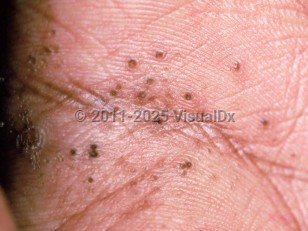Porokeratotic eccrine ostial and dermal duct nevus in Adult
Alerts and Notices
Important News & Links
Synopsis

Porokeratotic eccrine ostial and dermal duct nevus (PEODDN) is a rare congenital nevus considered part of the spectrum of porokeratotic adnexal ostial nevi (PAON). This clinical complex includes porokeratotic eccrine and hair follicle nevus (PEHFN); both feature coronoid lamellae and dilated acrosyringia, but PEHFN demonstrates extension into the hair follicle.
Although considered a sporadic disorder, familial cases of PEODDN have been reported. Mutations in GJB2 (connexin 26) have been proven as causative via epidermal hyperproliferation owing to aberrant calcium metabolism. PEODDN also occurs in patients with Keratitis-ichthyosis-deafness (KID) syndrome (also caused by connexin 26 mutations). As with other mosaic conditions, the existence of a PEODDN may confer increased risk of transmitting a connexin mutation causing KID syndrome in offspring.
PEODDN typically appears within the first few years of life and is asymptomatic, although pruritus has been reported. Classically, it is described as linearly distributed keratotic papules and plaques with a comedo-like appearance. Verrucous lesions may also be observed. These eccrine hamartomas are most often found on the extremities, the palms and soles being most common. Rare cases also feature concurrent verruciform xanthomas or ipsilateral calcinosis. Extensive lesions may be associated with musculoskeletal anomalies such as limb shortening.
Squamous cell carcinoma arising within PEODDN has been reported, and thus clinical follow up is advisable. There are reports of PEODDN in patients with hearing loss, neurologic, and endocrine abnormalities.
Although considered a sporadic disorder, familial cases of PEODDN have been reported. Mutations in GJB2 (connexin 26) have been proven as causative via epidermal hyperproliferation owing to aberrant calcium metabolism. PEODDN also occurs in patients with Keratitis-ichthyosis-deafness (KID) syndrome (also caused by connexin 26 mutations). As with other mosaic conditions, the existence of a PEODDN may confer increased risk of transmitting a connexin mutation causing KID syndrome in offspring.
PEODDN typically appears within the first few years of life and is asymptomatic, although pruritus has been reported. Classically, it is described as linearly distributed keratotic papules and plaques with a comedo-like appearance. Verrucous lesions may also be observed. These eccrine hamartomas are most often found on the extremities, the palms and soles being most common. Rare cases also feature concurrent verruciform xanthomas or ipsilateral calcinosis. Extensive lesions may be associated with musculoskeletal anomalies such as limb shortening.
Squamous cell carcinoma arising within PEODDN has been reported, and thus clinical follow up is advisable. There are reports of PEODDN in patients with hearing loss, neurologic, and endocrine abnormalities.
Codes
ICD10CM:
D23.9 – Other benign neoplasm of skin, unspecified
SNOMEDCT:
239118007 – Porokeratotic eccrine ostial and dermal duct nevus
D23.9 – Other benign neoplasm of skin, unspecified
SNOMEDCT:
239118007 – Porokeratotic eccrine ostial and dermal duct nevus
Look For
Subscription Required
Diagnostic Pearls
Subscription Required
Differential Diagnosis & Pitfalls

To perform a comparison, select diagnoses from the classic differential
Subscription Required
Best Tests
Subscription Required
Management Pearls
Subscription Required
Therapy
Subscription Required
References
Subscription Required
Last Reviewed:07/18/2021
Last Updated:08/10/2021
Last Updated:08/10/2021
Porokeratotic eccrine ostial and dermal duct nevus in Adult

